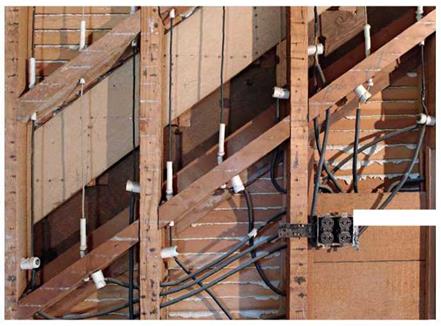Insects: Hungry for a Home
If you’d like to buy a house, make your offer contingent on a licensed pest – control inspector’s report. You probably won’t see insects, but you might see any of these signs:
► Sandy brown tubes, in. in diameter, that run up a foundation wall and wood burrows that run parallel with the grain indicate the presence of subterranean termites.
► Pellets outside insect entry holes and burrowing in all directions of wood grain, with no tubes on the foundation, indicate non-subterranean termites.
► Holes that may range from pin size to BB size and light-colored powdery debris indicate powderpost beetles.
► 
 Coarse sawdust beneath damp wood with galleries excavated parallel with the wood grain indicates carpenter ants. Simply spraying carpenter ant nests usually does the trick.
Coarse sawdust beneath damp wood with galleries excavated parallel with the wood grain indicates carpenter ants. Simply spraying carpenter ant nests usually does the trick.

![]()

this case, upsize the concrete pads beneath the posts or replace posts. In some cases, shorten joist spans by adding girders and posts beneath.
Wooden posts rotting at the bottoms suggest that moisture is wicking up from the ground through the concrete pad. Replace the posts, putting a metal or plastic moisture barrier between their bottoms and the concrete.
Joists and girders may have been seriously weakened by cutting to accommodate ducts and drainpipes. See "Maximum Sizes for Holes and Notches,” on p. 287, for information about how much and where you can safely cut and drill structural members.
Mechanical systems include electrical, plumbing, and HVAC. Your comfort and safety depend on up-to-date and adequately sized mechanicals, as they are called.

![]() Using a voltage tester, you can safely see if house receptacles are operable. If the cover plates of any receptacles are warm, if tester lights flicker, or if there’s an odd smell, there may be aluminum circuit wiring in the walls, which tends to overheat and cause fires. Have your electrician check for this too.
Using a voltage tester, you can safely see if house receptacles are operable. If the cover plates of any receptacles are warm, if tester lights flicker, or if there’s an odd smell, there may be aluminum circuit wiring in the walls, which tends to overheat and cause fires. Have your electrician check for this too.
To prevent electrical shocks in high-moisture areas, all bathroom receptacles, kitchen receptacles within 4 ft. of a sink, outdoor outlets, and some garage outlets must be GFCIs. Your local building code will have the final say on GFCIs.
Questions suggested under "Kitchen and Bathrooms,” earlier in this chapter, should be addressed here, too—particularly if you noted water damage around tubs or toilets. By the way, if the house has only a crawl space, replacing the plumbing will take longer and be more costly than if it has a basement.
Drainage, waste and vent (DWV) pipes should be replaced if they’re rusted, corroded, or leaking. Waste pipes past their prime often show powdery green or white deposits along their horizontal runs, where wastes accumulate. Also, if joists around the closet bend are discolored, probe for rot. If rotted, they’ll need to be replaced.
Supply pipes. If water pressure is poor and plumbing is old, it’s likely that the pipes are galvanized iron. With a typical life span of about 25 years, the fittings rust out first.
Copper pipe will last indefinitely unless the water is acidic, in which case you’ll see blue – green deposits on fixtures and pinhole leaks in the pipe. But if copper pipes aren’t too far gone, an acid-neutralizing filter on supply lines may cure the problem.
If the house has a septic tank, ask when it was last emptied. Most tanks are sized according to the number of users and should normally be emptied every few years. Also inquire how the owner determines the exact location of the tank’s clean-out lid, which will usually be buried under more than 1 ft. of soil.
Then walk the area. If the ground is damp and smelly, the most recent servicing wasn’t soon enough. Besides tardy servicing, this could indicate that the tank or the drainage field may be undersize, clogged, or incorrectly installed. A new septic system is a significant expense.
Copper and galvanized pipe joined together will corrode, owing to a process called galvanic action. To join these metals, you need to install a dielectric union between them.
A water test by the health department should be part of the purchase agreement; this is especially important if the house has its own well.
Water heaters. Water heaters 10 years to 12 years old should be replaced. A manufacturer’s plate on the heater will tell its age and capacity.
As a rule of thumb, a 40-gal. gas-fired water heater is about right for a family of four. Electric water heaters should be 50-gal. capacity because they recover a little slower.
 |
 |
There should be a temperature-pressure relief (TPR) valve on or near the top of the water heater. Without TPR protection, a water heater can explode and level the house. If the TPR valve drips, you’ll need to replace it. If you own the home, make sure you have a TPR valve.
Gas lines that smell and corroded gas pipes are unsafe: Call the gas utility immediately. (Most provide a free inspection.) Gas lines are typically "black iron” pipe with threaded fittings or copper joined by flared fittings. Gas lines should never include PVC plastic pipe, sweated (soldered) copper joints, or compression fittings such as those used for water supply.






Leave a reply